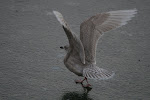
The Great
Orme is renowned for its potential when it comes to
visible migration, but today is widely regarded as 'The best spring day on the
Orme ever!' Chris Bridge,
Hamza and I got up the top for first light with the first birds of note being a male Ring
Ouzel and a small passage of
Redpoll and Meadow Pipits. Reaching the start of the limestone pavement, news came in of a Short-eared Owl found by 'Marc Buzzard' whom was also on the
Orme bright and early along with Alan Davies and Robin
Sandham among others. It really wasn't long before we had the
Shortie ourselves, shortly followed by 2
Chough and a wader calling which turned out to be the female
Dotterel present the day before. It circled 5 times calling almost constantly. This is my earliest
Dotterel to date, and a very early bird indeed! The group of us spread out slightly on the pavement where pretty much all of us managed to connect with over-flying Lapland Bunting (in summer plumage!), Yellow Wagtail, and throughout the day 300+
Redpoll,
Crossbill and a steady passage of Linnet, Meadow Pipit,
Woodpigeon and a flock of 9 Golden Plover. Totals during the day inc:
Dotterel, Short-eared Owl, 2 summer
plumage Lapland Buntings, 2 Yellow Wagtails, 2 Tree Pipits, 2 Ring
Ouzel, Common
Redstart,
Whitethroat, Grasshopper warbler, Garden Warbler, 6
Blackcap, 50+
Wheatear, 9 Golden Plover,
Brambling, 2
Crossbill, 15+ Willow Warbler, 10+
Chiffchaff.

above - Dotterel at first light
It was a truly amazing morning for passage, until we got the horrible news that we'd missed an Arctic
Redpoll and a possible Greenland
Redpoll (a possible first for Wales!) by the path up to the pavement. I arrived at the location where I was shown some gripping images of the little gems! Whilst present, I noted 1 of the 5+ Mealy
Redpoll which was a little consolation. Chris,
Hamza and I wandered off after it calmed down a little and decided to lay down on the grass watching birds flying overhead in the late morning's sun. A steady passage of '
Mipits' and '
redpoll sp' was
interrupted when Chris heard a familiar 'chirrup' which set alarms bells ringing, but was quickly dismissed. He heard it again and asked me, 'Is that...Red-rump?'. I listened out intently and heard the bird do a set of calls for the third time. It was pretty distinctive and
reminiscent of Catalonia from 2007, 08, 09 and 2010! I frantically scanned the sky until I got in my binoculars a
hirundine sp high up, which had the general shape of Swallow, but its flight was far more erratic and jittery. I observed a peachy underside with a black tail and black
undertail coverts
contrasting boldy with the bright belly. As the bird flew over, it banked
slightly, and I was just able to pick out pale sides to the rump, essentially clinching
Red-rumped Swallow! The bird flew strongly
NNW out towards the Irish Sea. Getting the news out, and discussing it afterwards with Marc, it suddenly hit home that we had found a first for
Conwy, and a lifer for myself...consolation for 'dipping' an Arctic
Redpoll if ever I saw one! (The bird was reported again at 14.58 on the limestone pavement which hopefully will aid our description!) A truly amazing day at one of the leading
migration sites in Britain!
 After the Royal Wedding had provided me with enough Luxurious cars and plane flyovers, i decided to do a spot of patching down at the quarry.
After the Royal Wedding had provided me with enough Luxurious cars and plane flyovers, i decided to do a spot of patching down at the quarry.






























